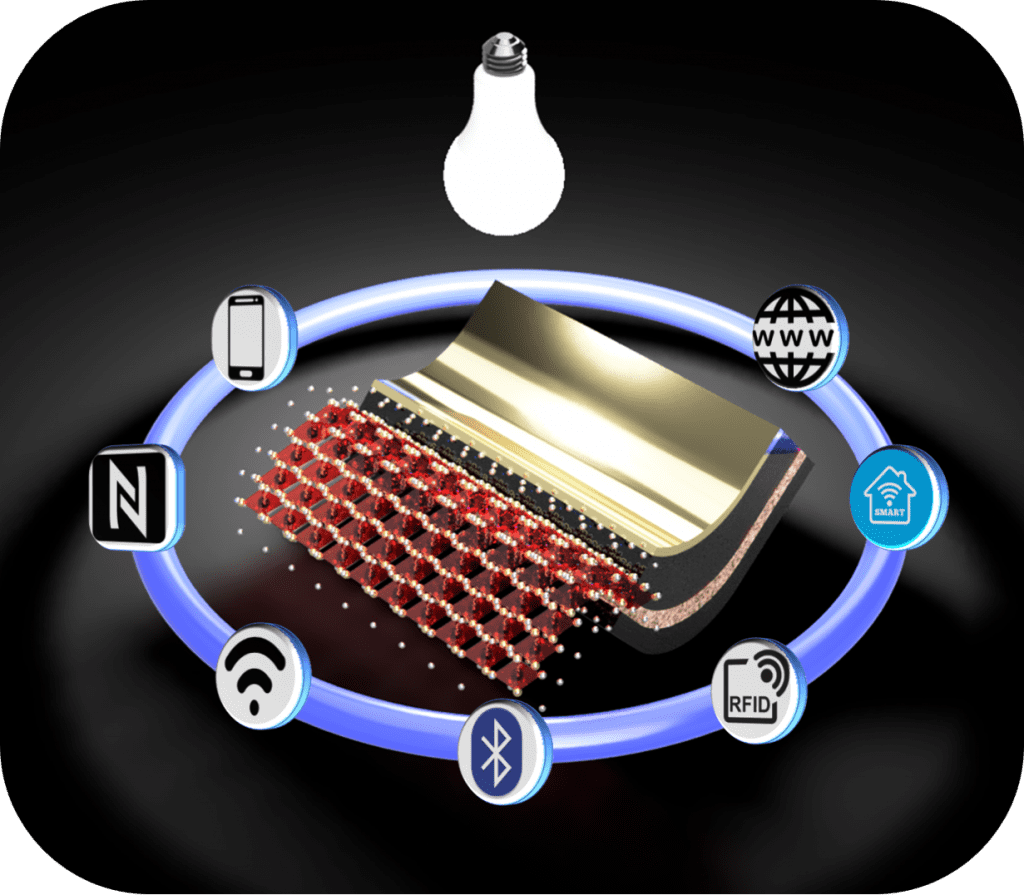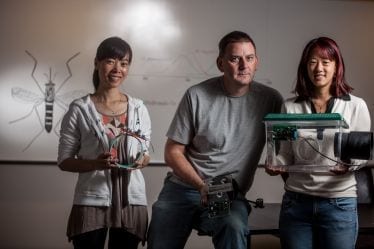Concept schematics showing a flexible perovskite photovoltaic cell illuminated by an indoor lamp able to generate significant power for a wide variety of devices including autonomous wireless sensors, low-power consumer electronics, smart homes, and the Internet of Things
A revolution is already under way which includes development of autonomous wireless sensors, low-power consumer electronics, smart homes, domotics and the Internet of Things. All these elements require efficient and easy-to-integrate energy harvesting devices for their power. Billions of wireless sensors are expected to be installed in interior environments over the coming decades.
Indoor photovoltaic (PV) power sources, on ultra-thin curvable substrates, will have the potential to facilitate these technological innovations if they can provide sufficient energy to the electronic components, while remaining small, convenient and economical. This type of energy supply will eliminate the need for batteries (whose replacement causes cost and work), and provide seamless integration.
PV cells must be developed on thin flexible substrates which can deliver excellent performance under indoor artificial lighting with the spectra and illumination levels found prevalently in homes, shops and offices (i.e. 100-500 lux). These values are between 2 and 3 orders of magnitude lower than those found outdoors under the sun (and which are used as standard test conditions for typical solar cells).
An international team with researchers from 3 countries has published the results of their project in an article in Cell Reports Physical Science, the open access journal from Cell Press, which highlights the progress made in advancing these goals.
The team members are from CHOSE (the Centre for Hybrid and Organic Solar Energy), Department of Electronic Engineering, University of Rome – Tor Vergata, from the Hydro Engineering and Agricultural Development Research Group (GHIDA), Faculty of Engineering, Universidad Surcolombiana, Neiva, Colombia, and from the Fraunhofer Institute for Organic Electronics, Electron Beam and Plasma Technology FEP from Dresden, Germany.
They report indoor power generation by flexible perovskite photovoltaic cells (PSCs) manufactured on roll-to-roll ITO (Indium Tin Oxide)-coated ultra-thin flexible glass (FG) substrates with excellent transmittance (> 80%), sheet resistance (13 ?/square) and bendability, surpassing 1600 bending procedures at 20.5mm curvature. They optimized perovskite photovoltaic cells on ultra-thin flexible glass by incorporating a mesoporous scaffold over SnO2 compact layers delivering a large leap forward in efficiency, reaching 20.6% (16.7 ?W/cm2 power density), and 22.6% (35.0 ?W/cm2) under 200 and 400 lux LED illumination respectively.
The efficiencies obtained represent the highest reported for any indoor photovoltaic cell technology that is flexible and curvable, as well as surpassing by a 60-90% margin the prior best-performing perovskite photovoltaic cells on flexible substrates. Specific powers in Watts delivered per gram of weight (W/g) are 40-55% higher than their counterparts on plastic PET films and an order of magnitude greater than those on rigid glass.
These figures underline the potential of seamless integration of these ultra-thin and ultra-light energy devices in indoor electronic components. All the active layers of the perovskite photovoltaic cells were deposited at low temperature and by solution processing, meaning that roll-to-roll fabrication of devices on ultra-thin flexible glass can not only be implemented for the ITO layer but also for all other layers by printing techniques in the future.
Additionally, glass, even in its flexible form, creates an exceptionally effective permeation barrier for gasses which are known to degrade perovskite materials, contributing to make this type of technology a prime candidate as key enabling power source for the indoor electronics of the future.
The Latest Updates from Bing News & Google News
Go deeper with Bing News on:
Indoor solar cells
- A low-energy process for high-performance solar cells could simplify the manufacturing process
Finding reliable, eco-friendly power sources is crucial as our world grapples with increasing energy needs and the urgent call to combat climate change. Solar energy offers one solution, with ...
- Low-energy process for high-performance solar cells
Finding reliable, eco-friendly power sources is crucial as our world grapples with increasing energy needs and the urgent call to combat climate change. Solar energy offers one solution, with ...
- TP-Link Tapo TC85: Secure Your Space
One of the challenges smart homeowners face when building a DIY smart home security system is making sure they have power and a solid wireless connection accessible to their outdoor security camera.
- Swedish startup wins EU funding to print organic indoor solar panels
Epishine's organic solar panels harness indoor light to power electronics and Internet of Things (IoT) devices.
- Korean researchers build vertical solar panels with low reflection losses
The modules are equipped with Maxeon solar cells and a microprism sheet that reportedly upholds a transmittance exceeding 99%. The microprism array is imprinted onto a PET sheet using the roll-to- ...
Go deeper with Google Headlines on:
Indoor solar cells
[google_news title=”” keyword=”indoor solar cells” num_posts=”5″ blurb_length=”0″ show_thumb=”left”]
Go deeper with Bing News on:
Energy harvesting
- Researchers Boost Energy Output by 4.5% with Reflective Surface Innovation
This groundbreaking solution demonstrates how a simple yet ingenious tactic, such as strategically positioning reflective surfaces, can substantially augment the efficiency of solar energy harvesting ...
- Purdue, Wabash National collaborate on composite trailer that recaptures its own energy
An experimental trailer that harvests its own electricity is anticipated to make trailers more sustainable and energy-efficient.
- Energy Harvesting Market Projected to Reach USD 1950 Million by 2033, with a 7.5% CAGR Forecast
The global energy harvesting market is estimated to attain a valuation of USD 940.7 million in 2023 and is projected to reach USD 1950 million by 2033, trailing a CAGR of 7.5% during the forecast ...
- Researchers make promising breakthrough in wave energy technology: 'New insight for the design and large-scale application'
This is an attractive idea for clean energy companies, as it does not face the same intermittency issues as wind and solar. Researchers make promising breakthrough in wave energy technology: 'New ...
- The Evolution Of Solar Energy: How Solar Panels Have Changed Over The Years
The evolution of solar is a long story that hasn't come close to finishing. Here's how solar panels have changed and evolved over the years.
Go deeper with Google Headlines on:
Energy harvesting
[google_news title=”” keyword=”energy harvesting” num_posts=”5″ blurb_length=”0″ show_thumb=”left”]











